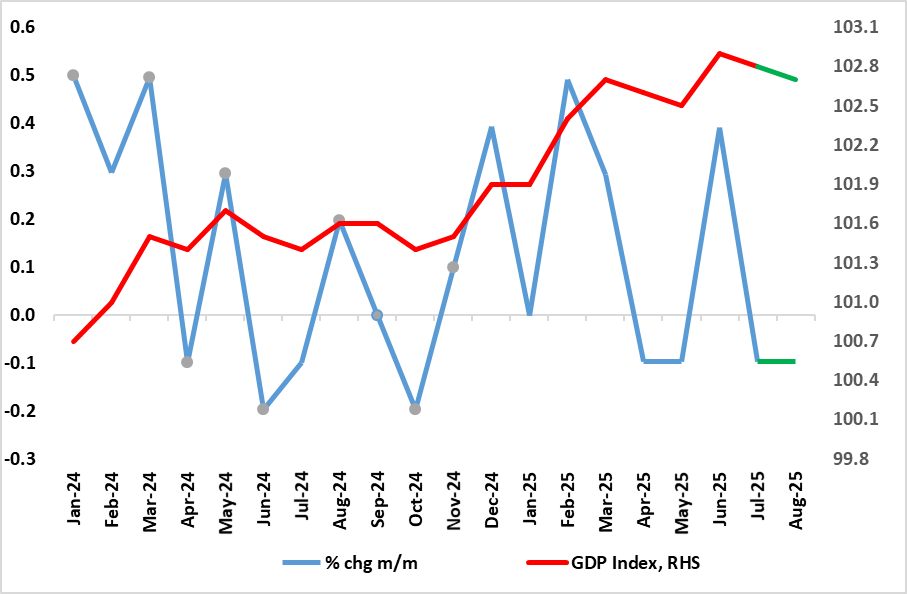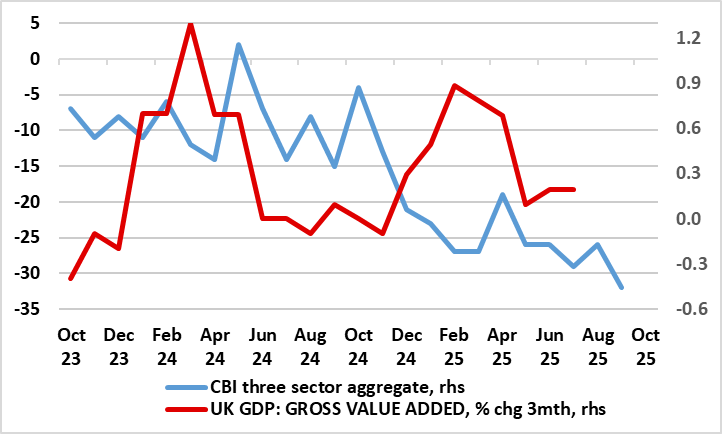UK GDP Preview (Oct 16): Conflicting Signs To Veer Toward Weakness
Although we are pointed to a flat m/m GDP outcome for the July data, thereby matching the official outcome, the actual outcome was a small m/m fall (before rounding). We see this being repeated in the August numbers with a 0.1% drop (Figure 1). This would leave the less volatile three-month rate at 0.2% but we think this overstates what is very feeble momentum, which may actually be nearer zero if not weaker at least according to some business survey data (Figure 2), especially one construction weakness is incorporated. Even so, at this juncture, the strong June outcome of 0.4% has created a solid backdrop for the last quarter GDP to support the BoE’s 0.3% Q3 forecast – even successive 0.1% m/m declines would still leave the quarter up 0.1% in q/q terms, that is without what may still be likely revisions but this remains our projection.
Figure 1: Solid GDP Growth Ebbing?

Source: ONS, CE, green line = CE forecast
To what extent better weather in July helped prevent a more discernible fall in the month’s GDP. But gauging the economy is all the more difficult given both conflicting signals and the extent to which the public sector has supported growth of late. The question is whether this latter factor will go in to reverse, sooner but probably later. As for conflicting signals this is best highlighted by recent headline regarding service sector surveys. Indeed, according to the CBI, activity across the services sector continues to weaken while August's PMI sees 'Steepest upturn in service sector output since April 2024'. Notably, the September PMI data more corroborates the CBI findings suggesting that UK service providers achieved only a marginal expansion of business activity as the rate of growth eased sharply since August amid sluggish demand conditions.
Figure 2: GDP Diverging from Surveys

Source: ONS, CBI, CE
As for August backdrop details, it does seem as if the housing market downturn has now filtered through into transactions, while industry data suggests a clear fall in vehicle production (which will only worsen in September given the problems JLR has faced). The weather in August was mixed but warm and dry, this possibly explaining the further gain in retail sales in the month. Given the near flat outcome we see for the whole of H2 we see that GDP growth this year may be around 1.2% (previous estimate sub-1%) but where more ominous signs suggest a) that the underlying economy has been growing far less appreciably and b) where downside risks still persist into next year, this highlighted by growing signs of an ailing housing market and clearer hints of an impending fiscal tightening.
I,Andrew Wroblewski, the Senior Economist Western Europe declare that the views expressed herein are mine and are clear, fair and not misleading at the time of publication. They have not been influenced by any relationship, either a personal relationship of mine or a relationship of the firm, to any entity described or referred to herein nor to any client of Continuum Economics nor has any inducement been received in relation to those views. I further declare that in the preparation and publication of this report I have at all times followed all relevant Continuum Economics compliance protocols including those reasonably seeking to prevent the receipt or misuse of material non-public information.